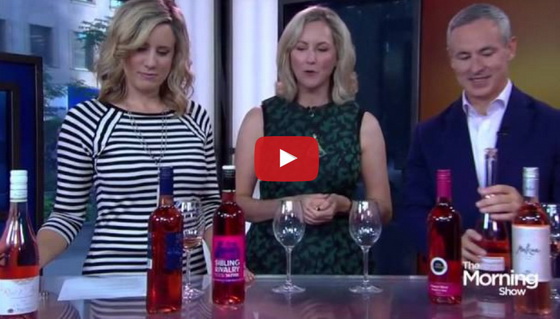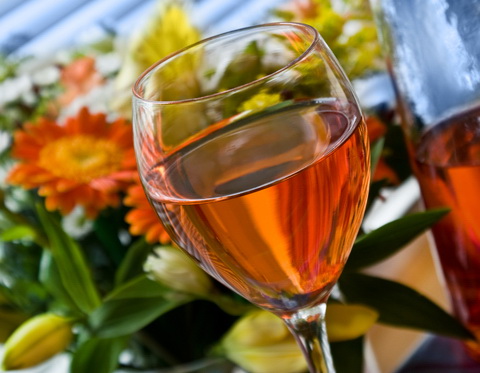One of the fastest growing categories in the liquor store is rosé wine.
Here to tell us why and which ones we should buy is Natalie MacLean, the editor of Canada’s most popular wine review site at nataliemaclean.com
– why has rosé had such a bad reputation in the past?
– how are modern rosés different in terms of how they taste?
– how are they different in terms of how they’re made?
– you’ve brought some today: which regions should we be looking for in the liquor store?
– how are Canadian rosés different from French ones?
– is white Zinfandel rosé?
– how should we serve rosé in terms of temperature, glass etc?
– what are some great food pairings?
– can you cellar rosé?
Beaurevoir Tavel Rosé
Rhône A.C., France
Gérard Bertrand Côte Des Roses Rosé
Languedoc, Midi A.P., France
Remy Pannier Rosé d’Anjou
Loire Valley, France
Sibling Rivalry Pink
Niagara Escarpment, Ontario V.Q.A., Canada
Henry of Pelham Winery Rosé
Niagara, Ontario V.Q.A., Canada
Trapiche Malkina
Mendoza, Argentina
Kim Crawford Pansy! Rosé
Hawke’s Bay, North Island, New Zealand
Charles Heidsieck Reserve Rosé Champagne
Champagne A.C., France
 Posted with permission from Global Television.
Posted with permission from Global Television.
Why is Rosé One of the Fastest Growing Wine Categories?
Liza: One of the fastest growing categories in the liquor store right now is Rosé wine and here to tell us why and which ones we should buy, is Natalie MacLean the editor of Canada’s most popular wine review site, good morning.
Natalie: Good morning Liza and Jeff.
Jeff: Good morning Natalie, nice to see you again.
Natalie: Good to be back.
Jeff: Why is Rosé exploding in popularity?
Natalie: You know, it has everything. It has flavour, it has food versatility and yet it doesn’t have the heavy oak or alcohol that we sometimes find in big reds or even in some of the whites. So it’s very versatile and it has come a long way. It has really changed since what we may have remembered from the 70’s or 80’s if we still have memories of those days.
Liza: Oh I remember even in the 90’s when Rosé came out “It was like pop.”
Natalie: It was.
Jeff: Yes.
Natalie: It was like alcohol flavoured by bubble gum and that’s where it got a bad reputation. But Rosés have changed in the way they’re made, dry styles, very elegant and they’re worth returning to.
Liza: Right, so let’s go through.
Natalie: Yes.
Jeff: Okay, well listen there, the proof is in the cork.
Natalie: Alright yes.
Liza: Yes right.
Jeff: Pour it for us.
Natalie: Yes, those empty glass … we can’t have that. So we’re going to start in France, the cradle of Rosé in the Southern Mediterranean, again, that’s why it’s so food friendly. We have a Remy Pannier from the Loire Valley and then right next to it we’re in the Languedoc. This is a beautiful bottle and I’m going to start with this one for you.
Liza: It is a beautiful bottle.
Natalie: Look at this, the Rosé rose on the bottom.
Jeff: Yes.
Liza: Wow!
Natalie: It’s made from Grenache grapes which also makes your big reds. I’m going to give you a sampling of this one.
Liza: Thank you.
Natalie: And you can try that.
Jeff: This is a very unique, it’s true.
Natalie: Isn’t that nice? It’s a glass stopper.
Jeff: Yes, it’s not cork.
Natalie: So it’s elegant.
Jeff: Yes.
Natalie: Now, some people save this for water afterwards.
Liza: That’s very smart. Actually it’s a gorgeous bottle.
Natalie: Isn’t that nice?
Jeff: I didn’t see the bottom… the rose in there.
Natalie: And it will go with Mediterranean dishes like your bouillabaisse or your garlicky dishes which we’re just talking about.
Jeff: That’s really nice.
Natalie: It’s good right?
Jeff: Yes.
Natalie: Like rose petals and fleeting strawberry notes.
Liza: That’s exactly what it is?
Natalie: Yes good.
Liza: I never would have said that like that.
Natalie: No.
Liza: It’s good.
Natalie: I don’t want to put the words on your mouth, just the Rosé.
Jeff: That’s why she’s the expert.
Liza: I know.
Natalie: So if we keep moving along here, we have Canadian Rosé and the next two are both from the Henry of Pelham. So we have the Henry of Pelham label and then we have Sibling Rivalry … it’s owned and operated by three Speck Brothers. They’re on the label, that’s the Sibling Rivalry.
Liza: I’ve heard good things about this.
Jeff: Yes.
Natalie: It is.
Liza: And not even just about the Rosé but in general with that label.
Natalie: That winery makes really big reds but what they’re proving, here, is, real men do drink pink. They are right on the label there.
Liza: Look at the difference.
Jeff: Yes.
Natalie: Isn’t that neat?
Jeff: Why is that darker?
Natalie: They’re using Cabernet Franc and a deeper pigmented Gamay. Over here, we have Grenache which is a lightly pigmented grapes.
Liza: Okay.
Natalie: So Rosé has a spectrum of colour, from onion skin pale to ballet slipper pink, to corals. The only danger sign is if it’s orangey-brown … then it is oxidized. You should drink Rosé young.
Liza: It’s very soft, smooth.
Natalie: Exactly, so it’s not a cellarable wine It’s only going to last a couple of years. You serve it chilled as we’re doing today because it’s the drink of refreshment. So we can keep going.
Jeff: Why stop now? We’re on to the new world, Natalie. That’s good.
Natalie: Why not?
Liza: Exactly.
Natalie: It’s Friday.
Liza: Yes.
Natalie: So over here, we have from New Zealand, Kim Crawford, Pansy!
Liza: Yes.
Natalie: It’s lovely … again, a very vibrant kind of Rosé. You’ll find the good Rosés come from cool climates like Canada and New Zealand.
Liza: I’m a fan of Kim Crawford overall and big fan of Sauvignon Blanc.
Natalie: So you know that they can make a really zippy white …
Liza: Yes.
Natalie: … and even a luscious Pinot Noir. But here’s the Rosé version and again, you have more ripe flavours of cherry-berry and field berries, making your mouth really happy.
Jeff: Next to it is a lighter Rosé?
Natalie: This is lighter, although sometimes the colour doesn’t always indicate the heft, the alcohol…
Jeff: Right.
Natalie: … or the flavour depths. This one is from Argentina and a little bit unusual in that we have a warmer climate. What they’re doing is fermenting it in cool temperatures to keep the freshness of the grapes. Technology has come a long way. The reason why Rosés are so fresh these days is that they can control the entire process.
Liza: Interesting.
Natalie: Yes and then we have Champagne. We shouldn’t forget Champagne.
Liza: No, we should not.
Jeff: Now since it’s Friday, let’s celebrate.
Natalie: Pink Champagne, yes exactly!
Jeff: Right yes!
Liza: Yes.
Natalie: Again we have a bit of a hangover image here, too. You might be surprised that Rosé Champagnes are the most expensive and rarest of Champagnes. We already think of Champagne as a luxury product.
Liza: Yes.
Natalie: Only 5% are Rosé. They’re very difficult to make because they blend three different grapes: Pinot Noir, Chardonnay, Pinot Meunier and they’re trying to get that same partridge eye colour.
Jeff: Yes.
Natalie: Every year, it’s the signature house lots, very difficult. You always find these Rosés are priced at a premium.
Liza: Right.
Natalie: Yes.
Liza: They do seem like something that is very celebratory when you see Rosés?
Natalie: It is.
Liza: Like you’re getting engaged? Or something like that?
Natalie: Absolutely, the drink of celebration. And it’s the drink of refreshment. If we circle back to France, even Southern France where they make the big reds, they can’t make zippy whites so they turn to Rosé. They use the same grapes but it is served chilled so it’s always refreshing.
Liza: Right.
Natalie: And it’s filling that gap while you wait for your reds to mature.
Jeff: Can I just say this is also the drink of intimidation because everybody is always so worried about uncorking.
Natalie: Yes.
Liza: I know.
Natalie: Exactly, it has to be cold enough.
Jeff: Yes.
Natalie: If you serve that warm, you’ll get the formula one 500.
Jeff: Everything, everywhere.
Liza: And I read or someone told me once as well, if you don’t want to sink all the money in the Champagne buy something called a Crema?
Natalie: Yes.
Liza: Is it a nice alternative.
Natalie: Yes, a Crema is from Burgundy so Champagne. If we look at a map of France, it is up North, Burgundy is right under and they make a Crémant de Bourgogne or Crema.
Liza: Yes.
Natalie: And they make it from the same grapes … so Chardonnay, Pinot Noir, … same grapes as Champagne and the same methods.
Liza: Yes.
Natalie: Double fermentation in the bottle, that’s how you trapped the bubbles.
Liza: Right.
Natalie: But a fraction of the price, so it’s a lovely alternative to Champagne.
Jeff: That’s interesting because this time in the morning, most people have a café Crema but not here on the morning show.
Liza & Natalie: No.
Jeff: No.
Natalie: These are great breakfast wines.
Liza: Bubbles.
Natalie: Excellent with granola.
Liza: Natalie MacLean, thank you so much.
Natalie: Thank you.
Liza: The best Rosés out there right now.
Natalie: Alright.
Liza: Nice to see you.
Jeff: Right.
Posted with permission of Global TV.
















